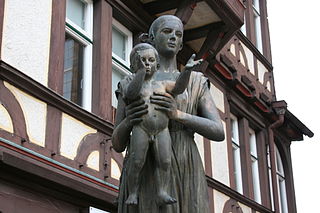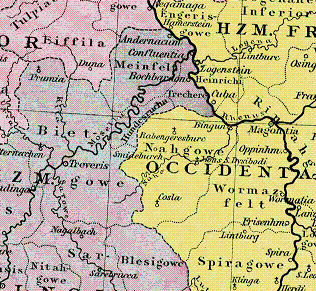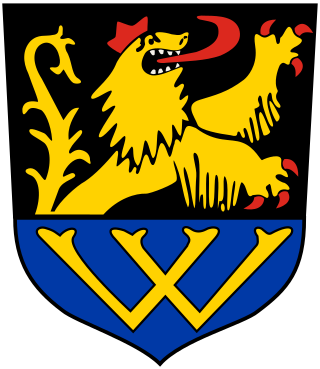
Reuss was the name of several historical states located in present-day Thuringia, Germany. Several lordships of the Holy Roman Empire which arose after 1300 and became Imperial Counties from 1673 and Imperial Principalities in the late 18th century were ruled by the House of Reuss.

Henry I of Hesse "the Child" was the first Landgrave of Hesse. He was the son of Henry II, Duke of Brabant and Sophie of Thuringia.
Ermengardeof Hesbaye, probably a member of the Robertian dynasty, was Carolingian empress from 813 and Queen of the Franks from 814 until her death as the wife of the Carolingian emperor Louis the Pious.

The Principality of Reuss-Gera, called the Principality of the Reuss Junior Line after 1848, was a sovereign state in modern Germany, ruled by members of the House of Reuss. It was one of the successor states of the Imperial County of Reuss. The Counts Reuss, with their respective capitals and Residenzen at Gera, Schleiz, Lobenstein, Köstritz and Ebersdorf, were all elevated to the title of prince (Fürst) in 1806. Their successor branch heads shared that title, while their cadets were also each titled prince (Prinz). Thus all males of the family were properly "Prince Heinrich Reuss, J.L.", without use of a nobiliary particle, although for convenience their branch names remained in colloquial use.
Henry Berengar (1136/7–1150), sometimes numbered Henry (VI), was the eldest son of Conrad III of Germany and his second wife, Gertrude of Sulzbach. He was named after his father's maternal grandfather, Emperor Henry IV, and his mother's father, Count Berengar II of Sulzbach. He was groomed for the succession, but predeceased his father.

Reuss-Ebersdorf was a county and from 1806 a principality located in Germany. The Counts of Reuss-Ebersdorf belonged to the Reuss Junior Line. Reuss was successively a part of the Holy Roman Empire, Confederation of the Rhine, German Confederation, North German Confederation, German Empire and Weimar Republic before becoming a part of Thuringia in 1920.

Reuss-Lobenstein was a state located in the German part of the Holy Roman Empire.
Henry was the leading military commander of the last years of the Carolingian Empire. He was commander-in-chief under Kings Louis the Younger and Charles the Fat. His early career was mostly restricted to East Francia, his homeland, but after Charles inherited West Francia in 884 he was increasingly active there. During his time, raids by the Vikings peaked in Francia. The sources describe at least eight separate campaigns waged by Henry against the Vikings, most of them successful.
The Robertians are the proposed Frankish family which was ancestral to the Capetian dynasty, and thus to the royal families of France and of many other countries. The Capetians appear first in the records as powerful nobles serving under the Carolingian dynasty of Charlemagne in West Francia, which later became France. As their power increased, they came into conflict with the older royal family and attained the crown several times before the eventual start of the continuous rule of the descendants of Hugh Capet.
Frances Louise Lockridge and Richard Orson Lockridge were American writers of detective fiction. The pair wrote 50 novels together, including one of the most famous American mystery series, Mr. and Mrs. North. They also wrote other series, including Lt Heimrich, Nathan Shapiro, and Paul Lane.
Lothair I was Margrave of the Nordmark from about 983 until his death. He was also a member of Saxon nobility as Count of Derlingau and of Nordthüringgau.
Poppo I was a Frankish count in the Grapfeld (Grabfeld) from 819–839. As a grandson of Heimrich, Count in the Upper Rheingau, he was a descendant of the Robertian count Cancor. He was the founder of the Frankish Popponids.
Cancor was a Frankish count associated with Lorsch Abbey. He was son of a noble lady Williswinda.

Heinzenhausen on the Lauter is an Ortsgemeinde – a municipality belonging to a Verbandsgemeinde, a kind of collective municipality – in the Kusel district in Rhineland-Palatinate, Germany. It belongs to the Verbandsgemeinde of Lauterecken-Wolfstein.
Renaud (795–843) was Frankish Count of Herbauges, Count of Poitiers and Count of Nantes. His name is also spelled Rainaldus or Ragenold, and he is sometimes known as Reginald in English. He is referred to as Renaud of Aquitaine, but seems to have been a member of the Rorgonid family of Maine.
Hinnerk is a Low German given name for boys. The name is the Low German version of the name Heinrich. Therefore it also succeeds the old high German name Heimrich which is composed of the old high German terms heim and rîhhi. Accordingly, Heinrich as well as Hinnerk mean the same as "landlord", "the lord of the house".

The Wormsgau was a medieval county in the East Frankish (German) stem duchy of Franconia, comprising the surroundings of the city of Worms and further territories on the left bank of the Upper Rhine river. Together with the neighbouring Nahegau and Speyergau, it belonged to the central Rhenish Franconian possessions of the Imperial Salian dynasty.
The Poppinids were an Frankish dynasty flourising in the early 9th century that originated from Grabfeld. They are named after their descent from Poppo of Grapfeld, who in turn descended from the Robertians. The Popponids gradually evolved into the Elder House of Babenberg. They were related to the Luitpoldings.

The Counts of Walbeck ruled a medieval territory with its capital Walbeck northeast of Helmstedt in the present town Oebisfelde-Weferlingen in Saxony-Anhalt. The foundation of the Archbishopric of Magdeburg established the region as firmly in the oversight of Otto the Great, Holy Roman Emperor. The first Count of Walbeck, Lothar I, was great-grandfather of Thietmar, Prince-Bishop of Merseburg, chronicler of the Ottonian dynasty of Germany and the Holy Roman Empire. Two of Thietmar’s great-grandfathers, both named Lothar, were killed in the Battle of Lenzen, pitting the forces of Henry the Fowler against the Slavs. The early Margraves of the Nordmark were descended from the House of Walbeck.
Lothar II the Elder, Count of Walbeck, son of Lothar I, Count of Walbeck.